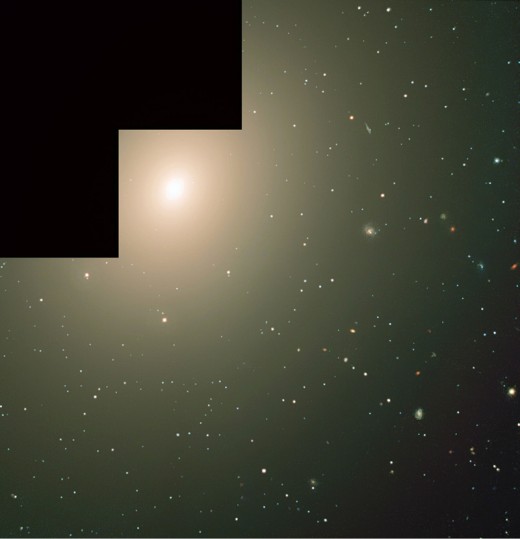
|
Credit:
Credit T. H. Puzia (Sternwarte Munich), S E. Zepf (Yale / Michigan State) et al., ESO, ESA, NASA
Explanation:
Elliptical galaxy NGC 4365 is old, probably about 12 billion years old.
Like most
elliptical galaxies, this galaxy was
thought to be full of old stars too, its burst of
star forming activity
having long since ended.
But combining data from the
Hubble Space Telescope
and the European
Southern Observatory's ground-based
Antu Telescope,
a team of European and
US
astronomers discovered
NGC 4365's surprising secret -- some of its star
clusters are young.
In this composite image,
the galaxy's bright nucleus is at the upper left.
NGC 4365's
star clusters
themselves appear as bright dots against
a diffuse glow of unresoved starlight and fuzzy, distant
background galaxies.
The notched border outlines
Hubble's WFPC2 camera field.
Moving the cursor over the image identifies individual star
clusters, with the relatively young (few billion year-old) clusters
circled in blue, and the anticipated 12 billion year-old clusters
circled in red.
NGC 4365
is 60 million light-years away in the
Virgo galaxy cluster.
Credit T. H. Puzia (Sternwarte Munich), S E. Zepf (Yale / Michigan State) et al., ESO, ESA, NASA
|
January February March April May June July August September October November December |
| ||||||||||||||||||||||||||||||||||||||||||||||||
NASA Web Site Statements, Warnings, and Disclaimers
NASA Official: Jay Norris. Specific rights apply.
A service of: LHEA at NASA / GSFC
& Michigan Tech. U.
Based on Astronomy Picture
Of the Day
Publications with keywords: NGC 4365 - Elliptical Galaxy - star cluster - star formation
Publications with words: NGC 4365 - Elliptical Galaxy - star cluster - star formation
See also:
